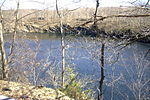Middle Branch Reservoir
Croton WatershedNew York (state) building and structure stubsProtected areas of Putnam County, New YorkReservoirs in New York (state)Reservoirs in Putnam County, New York

Middle Branch Reservoir is a reservoir in the New York City water supply system located in the Town of Southeast in Putnam County, 35 miles (65 km) north of the city. Created in 1878 by damming the Middle Branch of the Croton River, it is one of twelve in the Croton Watershed. Middle Branch covers 400 acres (1.6 km²), with an average depth of 31 feet (9.4 m), although some areas in the reservoir's southern extent reach 50 feet (15 m). It drains an area of 21 square miles (55 km²) reaching into Dutchess County. At full capacity, it holds 4.1 billion gallons (6.4 million m³).
Excerpt from the Wikipedia article Middle Branch Reservoir (License: CC BY-SA 3.0, Authors, Images).Middle Branch Reservoir
Maple Road, Town of Southeast
Geographical coordinates (GPS) Address Nearby Places Show on map
Geographical coordinates (GPS)
| Latitude | Longitude |
|---|---|
| N 41.39 ° | E -73.648611111111 ° |
Address
Maple Road
Maple Road
10508 Town of Southeast
New York, United States
Open on Google Maps






